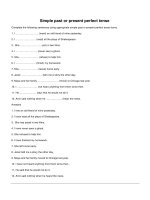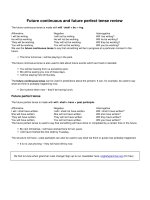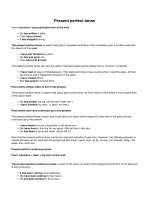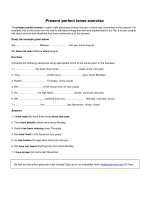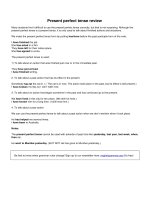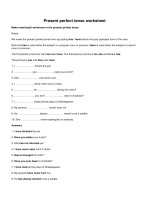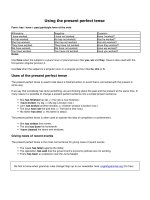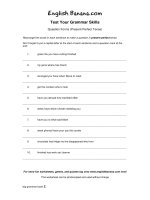Present perfect tense review
Bạn đang xem bản rút gọn của tài liệu. Xem và tải ngay bản đầy đủ của tài liệu tại đây (8.29 KB, 1 trang )
Present perfect tense review
Many students find it difficult to use the present perfect tense correctly, but that is not surprising. Although the
present perfect tense is a present tense, it is only used to talk about finished actions and situations.
We make the present perfect tense form by putting
has/have
before the past participle form of the verb.
I
have finished
the job.
She
has acted
in a film.
They
have left
for their native place.
She
has agreed
to come.
The present perfect tense is used:
1) To talk about an action that was finished just now or in the immediate past.
They
have just arrived.
I
have finished
writing.
2. To talk about a past action that has its effect in the present.
Somebody
has let
the cat in. (= The cat is in now. The action took place in the past, but its effect is still present.)
I
have broken
my leg, so I can’t walk now.
3. To talk about an action that began sometime in the past and has continued up to the present.
We
have lived
in this city for ten years. (We still live here.)
I
have known
him for a long time. (I still know him.)
4. To talk about a past action
We can use the present perfect tense to talk about a past action when we don’t mention when it took place.
He
has helped
me several times.
I
have been
to Australia.
Notes
The
present perfect tense
cannot be used with adverbs of past time like
yesterday, last year, last week, when,
then
etc.
He
went to Mumbai yesterday
. (BUT NOT He has gone to Mumbai yesterday.)
Be first to know when grammar rules change! Sign up to our newsletter here: englishgrammar.org (It's free)
Powered by TCPDF (www.tcpdf.org)
